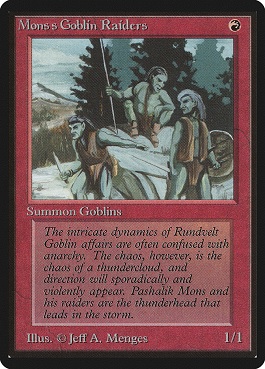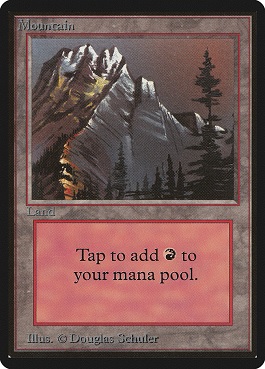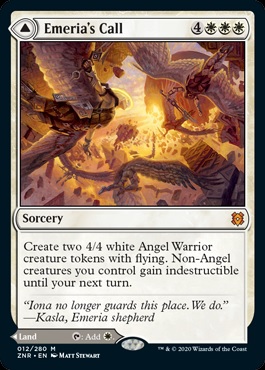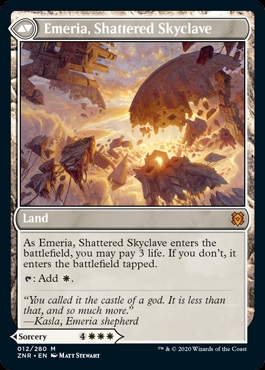When is a land not just a land?
Before Zendikar Rising, there were a number of answers to this question. There have been creature lands like Mutavault and Creeping Tar Pit, lands that replace themselves like Forgotten Cave and Fetid Pools, lands that act like spells like Blighted Fen or Shefet Dunes, lands that act like artifacts like Blast Zone or Desert, as well as lands that act like enchantments in Field of the Dead or The Tabernacle at Pendrell Vale. However, while these cards all acted like other card types, they were still lands.
Zendikar Rising changes that.
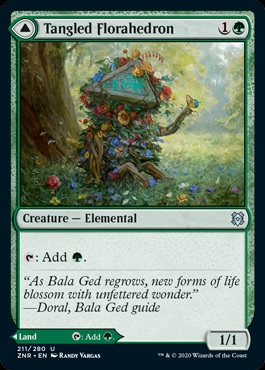 |  |
Double-face cards return, but not in a way you might expect.
The double-face cards in Zendikar Rising are spells on their front side and lands on the back. They operate more like split cards than double-face cards, giving you the option when you play them of choosing the land or the spell side. Once chosen, your choice remains unless the card is returned to your hand in some way. This gives us a level of flexibly we've never really seen before in Magic.
Magic has always been built around the mana system. Decks are comprised of two unique elements, lands and spells, and the challenge is the balance them in a manner that allows them to work best together. This is why we don't see 30 land aggro decks or 16 land ramp decks; the lands you choose to play alongside your spells and core strategy is perhaps one of the most important elements of deck-building.
As such, these new cards are a completely new deck-building element.
We've seen some things like this before. In some ways cycling fulfills this purpose, allowing you more options with your spells when you need something else. Specifically, land cycling effects like Twisted Abomination give you the direct option of land or a spell, but at a mana cost. But this is the first time you get a direct choice for an actual spell or actual land with no extra investment.
This is extremely powerful.
Imagine your typical Mono-Red Aggro deck - 20 lands, 20 creatures, 20 spells, usually mostly burn spells. These decks want to draw 2 or 3 lands and a good mix of creatures and spells, but when they draw too much or two few of any of these elements they can stumble and lose their early aggressive window. Now imagine that 8 of those lands were also low impact spells, allowing the Red deck to draw that game winning spell on turn six rather than land number five.
This is a monumental deviation from the norm.
If it was as simple as:
Awesome Land Goblin
![]()
![]()
Creature - Goblin
2/1
/ Flipside /
Awesome Goblin Land
Land
Tap: Add ![]() .
.
We would probably have a huge issue that would break the most fundamental aspect of what makes Magic, well Magic. Thankfully, with the cards we've seen so far at least, Wizards of the Coast looks to have done a good job at balancing the utility and flexibility of these cards.
The Spell Side
With the early previews so far, it's pretty clear we're not going to see Tarmogoyf or Lightning Bolt on the front side of these new spell-lands. Like cards with cycling, the effects are going to be a bit narrower because you have the option to do something else and aren't stuck with a narrow effect if you can't use it profitably. However, unlike cycling you are not going to want a land in the mid to late game, meaning your narrow spell is just going to be a narrow spell.
This is a large opportunity cost. However, if the spell side is going to be good for then these are going to be very good. Narrow effects like Disenchant, Lava Dart, or life gain are going to be very good when the matchup calls for them, meaning if you're getting that kind of upside out of a pseudo-land slot you're going to be very happy.
The Land Side
This is where things get a big murky. Didn't I just write a whole article about how tap lands suck?
Single color taplands are a huge drag on your production. We've seen this very often over the years, as taplands are a major drain on your early turns. This has made colored lands with good abilities never really see much play because the tapland downside just wasn't worth the effort. We've seen this with the cycling lands like Barren Moor, as well as lands that have good abilities like Oran-Rief, the Vastwood, Gingerbread Cabin, or Memorial to Glory; the benefit just doesn't outweigh the possibility of early stumbles. If you're fixing your mana so you can cast your spells that's one thing, but without that the benefit has to be very good.
We're also in a new age of Magic, where players rarely run out of things to do. There's always a Uro, Titan of Nature's Wrath to escape, a Hydroid Krasis or planeswalker to draw you cards, or even a companion to lean into. While old school Magic was much more about answers and card advantage, modern Magic is more about cascading threats and trying to build a snowballing advantage. This makes taplands even more of a liability and the need to cash your lands in for action less important. Lastly, Standard also has the Castle Ardenvale cycle, which further helps to alleviate mana flood for a very low opportunity cost.
The Whole Picture
The potential is here for this mechanic to literally break the game of Magic in half, but it looks like Wizards of the Coast has been wisely leaning conservative on allowing these cards to be mostly Limited or Standard cards, and that's great! For a Limited format that is going to have a number of landfall themed effects, being able to choose between a land or a spell in the midgame seems awesome, and it's going to be really awesome to figure out your land counts for your draft decks.
In fact, that's the real question here. Even if they aren't overpowered, these cards aren't to be underestimated. It's going to be extremely interesting to see how these cards effect how we build our mana bases going forward.
Let's take a quick look at a few of the spell-lands we have so far.
 |  |
Now on the face, neither Tangled Florahedron nor Tangled Vale is a very good Magic card. Tangle Florahedron pales in comparison to something like Paradise Druid or Llanowar Elves in raw power level, although it does get the basic job of ramping from two to four mana done. Tangle Vale is significantly worse than a forest, but to a player who is mana screwed or has no use for the mana on the turn they want to play it, it is certainly functionally similar. But having the option here is quite impressive.
The complaint here is that neither card is a good draw in the mid to late game. Having the ability to cycle a Llanowar Elves later in the game would be amazing, but having it be a bad land isn't that exciting. Still, two-mana ramp creatures have a great pedigree in Standard so we shall see.
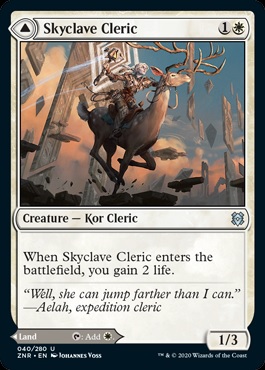 | 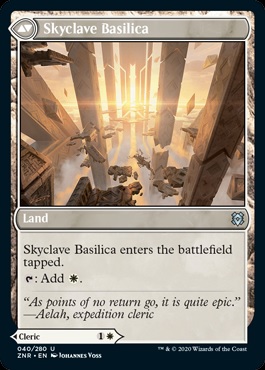 |
Skyclave Cleric is awesome. Unlike Tangled Florahedron, Skyclave Cleric is a much more focused card that is excellent at what it does but is mediocre otherwise. We've seen all sorts of life gain blocker cards as anti-Red sideboard cards over the years, from Bottle Gnomes to Arashin Cleric, and Skyclave Cleric fits the mold.
But the exciting part is that against midrange and control decks, you're more than happy to have Skyclave Basilica. Control mirrors are often about making as many land drops as possible, giving Skyclave Cleric a great dual use where it is useful for different things in different matchups. This one is exciting!
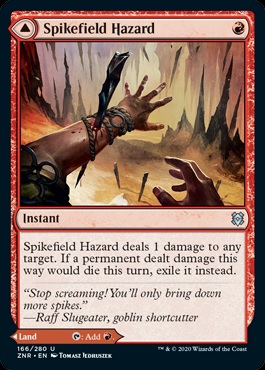 | 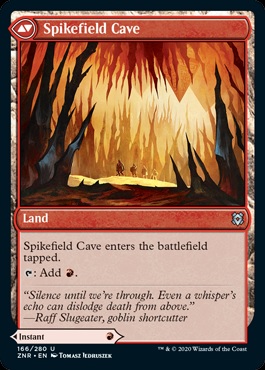 |
Speaking of powerful but narrow effects, Spikefield Hazard is one of the most impressive spell-lands previewed so far. It's not that far off of Magma Spray, a maindeckable card in some formats, and if you're killing a Birds of Paradise or Selfless Savior you won't be able to tell the difference between it and Lightning Bolt.
And again, we have the same idea as Skyclave Cleric where in the matchups where your opponent doesn't have lots of 1 toughness creatures, you will probably be playing a longer game and be more than happy to have the land drop.
Okay, forget everything I said about taplands!
Emeria's Call seems to be part of a mythic cycle of spell-lands that don't need to enter the battlefield tapped, as you are given the option to pay three life and have it come in untapped instead. Three life is a lot, but this is a huge upgrade to have this option rather than always entering tapped. While the other spell-lands feel more like spells that are going to be lands sometimes, this mythic cycle feels much more like lands with huge late game upside.
Emeria's Call is a passable but not extremely powerful spell, but when you look at it as sort of a super Castle Ardenvale that's a land most of the time but also a good draw later in the game, it looks very appealing. Assuming this is a cycle, these are going to be some of the most important cards in the set.
Flipping New Ground
This is a very exciting new mechanic.
It has great potential to be powerful, as well as being exceedingly interesting in both gameplay as well as deck-building. Any time a new card or mechanic makes us rethink how we build our decks, it's a win in my book.
Don't expect the world, but don't underestimate these either. They are subtly very powerful.
















